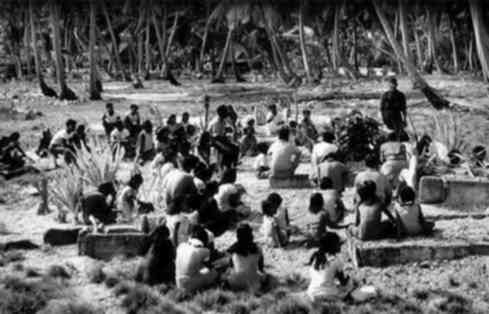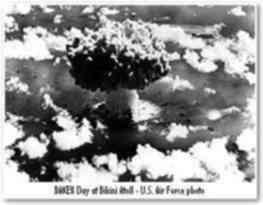Bikini Atoll History 2/4
While the 167 Bikinians were getting ready for their exodus, preparations for the U.S. nuclear testing program advanced rapidly. Some 242 naval ships, 156 aircraft, 25,000 radiation recording devices and the Navy’s 5,400 experimental rats, goats and pigs soon began to arrive for the tests. Over 42,000 U.S. military and civilian personnel were involved in the testing program at Bikini.
The nuclear legacy of the Bikinians began in March of 1946 when they were first removed from their islands in preparation for Operation Crossroads. The history of the Bikinian people from that day has been a story of their struggle to understand scientific concepts as they relate to their islands, as well as the day-to-day problems of finding food, raising families and maintaining their culture amidst the progression of events set in motion by the Cold War that have been for the most part out of their control.
 In preparation for Operation Crossroads, the Bikinians were sent 125 miles eastward across the ocean on a U.S. Navy LST landing craft to Rongerik Atoll. The islands of Rongerik Atoll were uninhabited because, traditionally, the Marshallese people considered them to be unlivable due to their size (Rongerik is 1/6 the size of Bikini Atoll) and because they had an inadequate water and food supply. There was also a deep-rooted traditional belief that the atoll was inhabited by evil spirits. The Administration left the Bikinians food stores sufficient only for several weeks. The islanders soon discovered that the coconut trees and other local food crops produced very few fruits when compared to the yield of the trees on Bikini. As the food supply on Rongerik quickly ran out, the Bikinians began to suffer from starvation and fish poisoning due to the lack of edible fish in the lagoon. Within two months after their arrival they began to beg U.S. officials to move them back to Bikini.
In preparation for Operation Crossroads, the Bikinians were sent 125 miles eastward across the ocean on a U.S. Navy LST landing craft to Rongerik Atoll. The islands of Rongerik Atoll were uninhabited because, traditionally, the Marshallese people considered them to be unlivable due to their size (Rongerik is 1/6 the size of Bikini Atoll) and because they had an inadequate water and food supply. There was also a deep-rooted traditional belief that the atoll was inhabited by evil spirits. The Administration left the Bikinians food stores sufficient only for several weeks. The islanders soon discovered that the coconut trees and other local food crops produced very few fruits when compared to the yield of the trees on Bikini. As the food supply on Rongerik quickly ran out, the Bikinians began to suffer from starvation and fish poisoning due to the lack of edible fish in the lagoon. Within two months after their arrival they began to beg U.S. officials to move them back to Bikini.
In July, the Bikinian leader, Juda, traveled with a U.S. government delegation back to Bikini to view the results of the second atom bomb test of Operation Crossroads, code named Baker. Juda returned to Rongerik and told his people that the island was still intact, that the trees were still there, that Bikini looked the same.
The two atomic bomb blasts of Operation Crossroads were both about the size of the nuclear bomb dropped on Nagasaki, Japan. Eighteen tons of cinematography equipment and more than half of the world’s supply of motion picture film were on hand to record the Able and Baker detonations, and also the movement of the Bikinians from their atoll.
From December of 1946 through January of 1947, the food shortages worsened on Rongerik; the small population of Bikinians was confronted with near starvation. During the same period of time, the area of Micronesia was designated as a United Nations Strategic Trust Territory (TT) to be administered by the United States. Indeed, it was the only strategic trust ever created by the United Nations. In this agreement, the U.S. committed itself to the United Nations directive to “promote the economic advancement and self-sufficiency of the inhabitants, and to this end shall…protect the inhabitants against the loss of their lands and resources…” The people of Bikini have long seen the irony in the conduct of the TT agreement that allowed the bombing of their homeland and that forced them into starvation on Rongerik Atoll.
Cheap Ed Hardy Womens Swimwear
Cheap Ralph Lauren Polo Swimwears

 Processing your request, Please wait....
Processing your request, Please wait....
